Department+of+Mechanical+Engineering
-
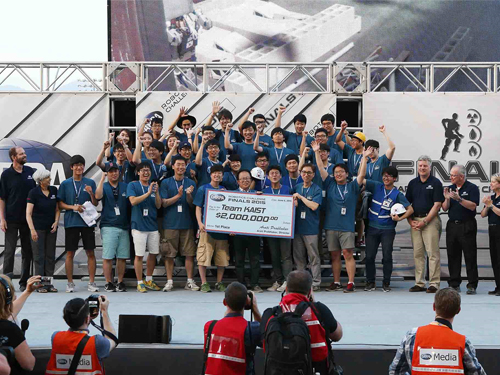 KAIST's DRC-HUBO Wins the DARPA Robotics Challenge 2015
DRC-HUBO finished all eight assignments in less than 45 minutes, taking first place among 24 international teams and claiming the USD 2 million prize offered by a US defense research agency.
The Robotics Challenge Finals 2015 hosted by the US Defense Advanced Research Projects Agency (DARPA) took place on June 5-6, 2015 at the Fairplex in Pomona, California.
Team KAIST of the Republic of Korea led by Professor Jun-Ho Oh of the Mechanical Engineering Department at the Korea Advanced Institute of Science and Technology (KAIST), Professor In-So Kweon of the Electrical Engineering Department, and researchers from Rainbow Co., the university’s spin-off company that builds the robots, won the DARPA Finals. The team received USD 2 million as a prize.
The DARPA’s Robotics Challenge (DRC) promotes a competition of robot systems and software teams which seek to develop robots capable of assisting humans in responding to natural and man-made disasters such as the Fukushima Daiichi nuclear incident in 2011. The DRC consists of three competitions: a software-based Virtual Robotics Challenge which took place in June 2013; the Robotics Challenge Trials in Homestead, Florida, in December 2013; and the Finals in June 2015.
A total of 24 teams from universities and private and public research institutes from Korea, the US, Hong Kong, Germany, Japan, and Italy participated in the Finals. The participating teams had to finish eight assignments in 60 minutes, during which their robots were untethered and operated wirelessly without communication from their engineers.
Each team was assigned a series of tasks: they included driving a vehicle, getting out of a vehicle, opening a door, turning a valve, drilling a hole in a wall, a surprise task such as pushing a button or turning on a switch, walking over rubble or debris, and climbing stairs. Robots scored a point each time they completed their missions. To win, a team had to complete all the tasks successfully in the shortest amount of time possible.
Team KAIST completed the entire course in 44 minutes and 28 seconds, followed by the Institute of Human and Machine Cognition (IHMC) Robotics in Pensacola, Florida in 50:26, and Team TARTAN Rescue of the National Robotics Engineering Center at Carnegie Mellon University in 55:15.
For details, see an article below from the New York Times:
New York Times, June 6, 2015
“Korean Robot Makers Walk Off With $2 Million Prize”
http://www.nytimes.com/2015/06/07/science/korean-robot-makers-walk-off-with-2-million-prize.html?_r=1
DRC-HUBO sticks a plug into an outlet for the surprise task at the 2015 DARPA Robotics Challenge on June 5-6, 2015, in Pomona, California.
DRC-HUBO turns a valve in a clockwise direction.
DRC-HUBO drills to cut a circle into the wall.
Members of Team KAIST pose together after the award ceremony on June 6, 2015.
2015.06.07 View 24673
KAIST's DRC-HUBO Wins the DARPA Robotics Challenge 2015
DRC-HUBO finished all eight assignments in less than 45 minutes, taking first place among 24 international teams and claiming the USD 2 million prize offered by a US defense research agency.
The Robotics Challenge Finals 2015 hosted by the US Defense Advanced Research Projects Agency (DARPA) took place on June 5-6, 2015 at the Fairplex in Pomona, California.
Team KAIST of the Republic of Korea led by Professor Jun-Ho Oh of the Mechanical Engineering Department at the Korea Advanced Institute of Science and Technology (KAIST), Professor In-So Kweon of the Electrical Engineering Department, and researchers from Rainbow Co., the university’s spin-off company that builds the robots, won the DARPA Finals. The team received USD 2 million as a prize.
The DARPA’s Robotics Challenge (DRC) promotes a competition of robot systems and software teams which seek to develop robots capable of assisting humans in responding to natural and man-made disasters such as the Fukushima Daiichi nuclear incident in 2011. The DRC consists of three competitions: a software-based Virtual Robotics Challenge which took place in June 2013; the Robotics Challenge Trials in Homestead, Florida, in December 2013; and the Finals in June 2015.
A total of 24 teams from universities and private and public research institutes from Korea, the US, Hong Kong, Germany, Japan, and Italy participated in the Finals. The participating teams had to finish eight assignments in 60 minutes, during which their robots were untethered and operated wirelessly without communication from their engineers.
Each team was assigned a series of tasks: they included driving a vehicle, getting out of a vehicle, opening a door, turning a valve, drilling a hole in a wall, a surprise task such as pushing a button or turning on a switch, walking over rubble or debris, and climbing stairs. Robots scored a point each time they completed their missions. To win, a team had to complete all the tasks successfully in the shortest amount of time possible.
Team KAIST completed the entire course in 44 minutes and 28 seconds, followed by the Institute of Human and Machine Cognition (IHMC) Robotics in Pensacola, Florida in 50:26, and Team TARTAN Rescue of the National Robotics Engineering Center at Carnegie Mellon University in 55:15.
For details, see an article below from the New York Times:
New York Times, June 6, 2015
“Korean Robot Makers Walk Off With $2 Million Prize”
http://www.nytimes.com/2015/06/07/science/korean-robot-makers-walk-off-with-2-million-prize.html?_r=1
DRC-HUBO sticks a plug into an outlet for the surprise task at the 2015 DARPA Robotics Challenge on June 5-6, 2015, in Pomona, California.
DRC-HUBO turns a valve in a clockwise direction.
DRC-HUBO drills to cut a circle into the wall.
Members of Team KAIST pose together after the award ceremony on June 6, 2015.
2015.06.07 View 24673 -
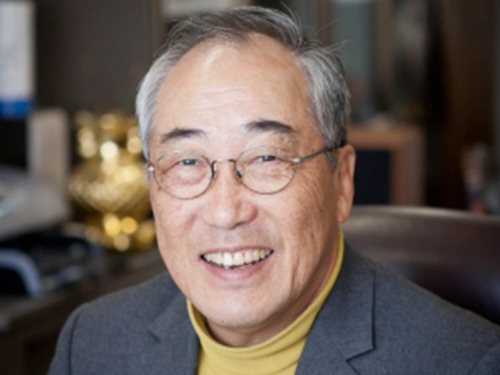 The Acoustical Society of America Names Yang Hann Kim of KAIST the Recipient of the 2015 Rossing Prize in Acoustics Education
The award, given to Dr. Kim in recognition of his contributions to the advancement of acoustics education, will be presented during the 170th Meeting of the Acoustical Society of America on November 2-6, 2015 in Jacksonville, Florida.
The Acoustical Society of America (ASA) announced today that Professor Yang Hann Kim of the Mechanical Engineering Department at the Korea Advanced Institute of Science and Technology (KAIST) was the 12th recipient of the Rossing Prize in Acoustics Education. Dr. Kim is the first recipient selected from a non-English-speaking nation.
The Rossing Prize in Acoustics Education was established in 2003 from a generous gift made to the ASA Foundation by Thomas D. Rossing to recognize an individual who has made significant contributions to the advancement of acoustics education through distinguished teaching, creation of educational materials, textbook writing, and other activities.
During 25 years of teaching and conducting research in acoustics, noise, and vibration at KAIST, Dr. Kim has advised 26 doctorates and published over 200 research papers in journals such as Journal of Acoustical Society of America, Journal of Sound and Vibration, and Journal of Mechanical Systems and Signal Processing. He also wrote two acoustics textbooks for university education, which has been widely read worldwide. The textbook titles are: Sound Propagation: An Impedance Based Approach (Wiley, July 2010) and with the co-author, Dr. Jung-Woo Choi, Sound Visualization and Manipulation (Wiley, September 2013).
Since 2009, Professor Kim has lectured an online course entitled “Introduction to Acoustics,” offering students and the general public throughout the world guidance to study acoustics through the basic concept of impedance, for example, on vibrations and waves.
Dr. Kim will receive the award during ASA’s 170th conference to be held on November 2-6, 2015 at the Hyatt Regency Jacksonville Riverfront Hotel in Jacksonville, Florida, USA.
For the list of previous recipients of the Rossing Prize in Acoustics Education,
see:http://acousticalsociety.org/funding_resources/prizes#rossing
2015.06.04 View 9733
The Acoustical Society of America Names Yang Hann Kim of KAIST the Recipient of the 2015 Rossing Prize in Acoustics Education
The award, given to Dr. Kim in recognition of his contributions to the advancement of acoustics education, will be presented during the 170th Meeting of the Acoustical Society of America on November 2-6, 2015 in Jacksonville, Florida.
The Acoustical Society of America (ASA) announced today that Professor Yang Hann Kim of the Mechanical Engineering Department at the Korea Advanced Institute of Science and Technology (KAIST) was the 12th recipient of the Rossing Prize in Acoustics Education. Dr. Kim is the first recipient selected from a non-English-speaking nation.
The Rossing Prize in Acoustics Education was established in 2003 from a generous gift made to the ASA Foundation by Thomas D. Rossing to recognize an individual who has made significant contributions to the advancement of acoustics education through distinguished teaching, creation of educational materials, textbook writing, and other activities.
During 25 years of teaching and conducting research in acoustics, noise, and vibration at KAIST, Dr. Kim has advised 26 doctorates and published over 200 research papers in journals such as Journal of Acoustical Society of America, Journal of Sound and Vibration, and Journal of Mechanical Systems and Signal Processing. He also wrote two acoustics textbooks for university education, which has been widely read worldwide. The textbook titles are: Sound Propagation: An Impedance Based Approach (Wiley, July 2010) and with the co-author, Dr. Jung-Woo Choi, Sound Visualization and Manipulation (Wiley, September 2013).
Since 2009, Professor Kim has lectured an online course entitled “Introduction to Acoustics,” offering students and the general public throughout the world guidance to study acoustics through the basic concept of impedance, for example, on vibrations and waves.
Dr. Kim will receive the award during ASA’s 170th conference to be held on November 2-6, 2015 at the Hyatt Regency Jacksonville Riverfront Hotel in Jacksonville, Florida, USA.
For the list of previous recipients of the Rossing Prize in Acoustics Education,
see:http://acousticalsociety.org/funding_resources/prizes#rossing
2015.06.04 View 9733 -
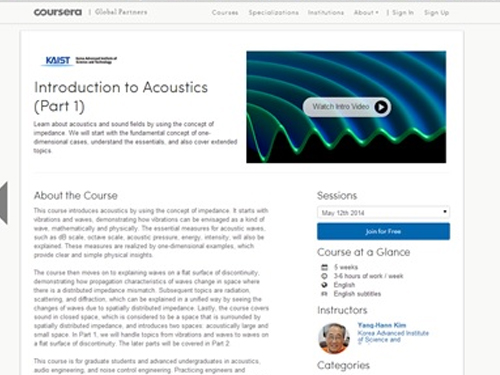 KAIST-Coursera Course: Introduction to Acoustics Engineering
Professor Yang-Hann Kim of Mechanical Engineering at KAIST has been offering an online course entitled “Introduction to Acoustics” on Corsera, the world’s largest MOOCs (Massive Open Online Courses) provider, from May 12th.
KAIST offered three Coursera classes during a spring semester in 2014, and Professor Kim’s course was the first one provided by the university to global learners.
Professor Kim has immersed himself in research and education on acoustics engineering for the past 30 years. His Coursera class has received positive responses from students, and some important data follows below:
For the past ten days, over 6,000 students from all around the world have enrolled the class. The student population consists of 33% in North America (United States and Canada), 32% in Europe, 23% in Asia, 8% in South America, and 2% in Africa. Arranged in order of countries, 25% of access originated from the United States, 8% from India, and 3% or 4% each from Brazil, Britain, Spain, Canada, Germany, Mexico, China, Russia, and France, and 2% from Korea.
The other two KAIST-Coursera classes are “Supply Chain Management: A Learning Perspective” and “Introduction to Light, Color, and Life.” For more information, please visit https://www.coursera.org/kaist.
2014.05.25 View 10309
KAIST-Coursera Course: Introduction to Acoustics Engineering
Professor Yang-Hann Kim of Mechanical Engineering at KAIST has been offering an online course entitled “Introduction to Acoustics” on Corsera, the world’s largest MOOCs (Massive Open Online Courses) provider, from May 12th.
KAIST offered three Coursera classes during a spring semester in 2014, and Professor Kim’s course was the first one provided by the university to global learners.
Professor Kim has immersed himself in research and education on acoustics engineering for the past 30 years. His Coursera class has received positive responses from students, and some important data follows below:
For the past ten days, over 6,000 students from all around the world have enrolled the class. The student population consists of 33% in North America (United States and Canada), 32% in Europe, 23% in Asia, 8% in South America, and 2% in Africa. Arranged in order of countries, 25% of access originated from the United States, 8% from India, and 3% or 4% each from Brazil, Britain, Spain, Canada, Germany, Mexico, China, Russia, and France, and 2% from Korea.
The other two KAIST-Coursera classes are “Supply Chain Management: A Learning Perspective” and “Introduction to Light, Color, and Life.” For more information, please visit https://www.coursera.org/kaist.
2014.05.25 View 10309 -
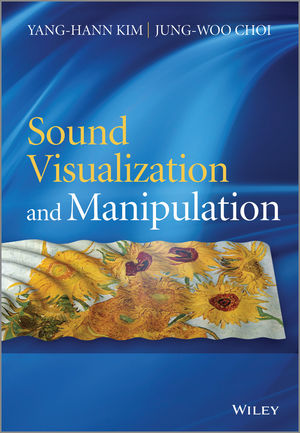 Book Announcement: Sound Visualization and Manipulation
The movie
Gravity
won seven Oscar awards this year, one of which was for its outstanding 3D sound mixing, immersing viewers in the full experience of the troubled space expedition.
3D audio effects are generated by manipulating the sound produced by speakers, speaker-arrays, or headphones to place a virtual sound source at a desired location in 3D space such as behind, above, or below the listener's head.
Two professors from the Department of Mechanical Engineering at KAIST have recently published a book that explains two important technologies related to 3D sound effects: sound visualization and manipulation.
Professor Yang-Hann Kim, an eminent scholar in sound engineering, and Professor Jung-Woo Choi collaborated to write Sound Visualization and Manipulation (Wily 2013), which uniquely addresses the two most important problems in the field in a unified way.
The book introduces general concepts and theories and describes a number of techniques in sound visualization and manipulation, offering an interrelated approach to two very different topics: sound field visualization techniques based on microphone arrays and controlled sound field generation techniques using loudspeaker arrays.
The authors also display a solid understanding of the associated physical and mathematical concepts applied to solve the visualization and manipulation problems and provide extensive examples demonstrating the benefits and drawbacks of various applications, including beamforming and acoustic holography technology.
The book will be an excellent reference for graduate students, researchers, and professionals in acoustic engineering, as well as in audio and noise control system development.
For detailed descriptions of the book:
http://as.wiley.com/WileyCDA/WileyTitle/productCd-1118368479.html
2014.03.10 View 14229
Book Announcement: Sound Visualization and Manipulation
The movie
Gravity
won seven Oscar awards this year, one of which was for its outstanding 3D sound mixing, immersing viewers in the full experience of the troubled space expedition.
3D audio effects are generated by manipulating the sound produced by speakers, speaker-arrays, or headphones to place a virtual sound source at a desired location in 3D space such as behind, above, or below the listener's head.
Two professors from the Department of Mechanical Engineering at KAIST have recently published a book that explains two important technologies related to 3D sound effects: sound visualization and manipulation.
Professor Yang-Hann Kim, an eminent scholar in sound engineering, and Professor Jung-Woo Choi collaborated to write Sound Visualization and Manipulation (Wily 2013), which uniquely addresses the two most important problems in the field in a unified way.
The book introduces general concepts and theories and describes a number of techniques in sound visualization and manipulation, offering an interrelated approach to two very different topics: sound field visualization techniques based on microphone arrays and controlled sound field generation techniques using loudspeaker arrays.
The authors also display a solid understanding of the associated physical and mathematical concepts applied to solve the visualization and manipulation problems and provide extensive examples demonstrating the benefits and drawbacks of various applications, including beamforming and acoustic holography technology.
The book will be an excellent reference for graduate students, researchers, and professionals in acoustic engineering, as well as in audio and noise control system development.
For detailed descriptions of the book:
http://as.wiley.com/WileyCDA/WileyTitle/productCd-1118368479.html
2014.03.10 View 14229 -
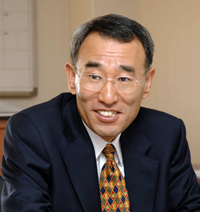 Professor Yong-Tak Im of Mechanical Engineering Appointed as President of Korea Institute of Machinery and Materials
Yong-Tak Im, Professor of the Department of
Mechanical Engineering at KAIST, was sworn in on February 25, 2014 as
the 16th president of the Korea Institute of Machinery and Materials
(KIMM), a leading government-funded research institution in Korea. KIMM was
established in 1976 to contribute to the development of
Korea through the invention of source technology and technology transfer in
mechanical engineering.
President Im graduated from Seoul National
University, obtaining degrees of Bachelor of Science and Master’s in mechanical
engineering. He later studied at the University of California in Berkeley and
received a doctoral degree in mechanical engineering.
After working as an assistant professor of
the Industrial and Systems Engineering at the Ohio State University,
President Im joined KAIST as a professor of mechanical engineering in 1989.
President Im took many important posts at
KAIST, including Dean of Planning Office, Dean of External Affairs and Public
Relations Office, and Associate Vice President of Special Projects and
Institutional Relations, making a great addition to the university’s endeavors for
globalization.
Among the awards President Im received was the
William Johnson Award in 2007 presented by the Advances in Materials and
Processing Technologies, the Research Achievement Award in 2010 by the Global
Congress on Manufacturing and Management, and the Presidential Award in 2012 by
the Republic of Korea. He was also elected as the vice president of the Korean
Society of Mechanical Engineers, the largest association of professionals in
the mechanical engineering field in Korea.
President Im is currently a professor at
POSCO, an internationally known Korean steel company, and a member of the
Korean Academy of Science and Technology and the National Academy of
Engineering of Korea, respectively.
President Im will serve KIMM for three
years until February 24, 2017.
2014.02.25 View 11569
Professor Yong-Tak Im of Mechanical Engineering Appointed as President of Korea Institute of Machinery and Materials
Yong-Tak Im, Professor of the Department of
Mechanical Engineering at KAIST, was sworn in on February 25, 2014 as
the 16th president of the Korea Institute of Machinery and Materials
(KIMM), a leading government-funded research institution in Korea. KIMM was
established in 1976 to contribute to the development of
Korea through the invention of source technology and technology transfer in
mechanical engineering.
President Im graduated from Seoul National
University, obtaining degrees of Bachelor of Science and Master’s in mechanical
engineering. He later studied at the University of California in Berkeley and
received a doctoral degree in mechanical engineering.
After working as an assistant professor of
the Industrial and Systems Engineering at the Ohio State University,
President Im joined KAIST as a professor of mechanical engineering in 1989.
President Im took many important posts at
KAIST, including Dean of Planning Office, Dean of External Affairs and Public
Relations Office, and Associate Vice President of Special Projects and
Institutional Relations, making a great addition to the university’s endeavors for
globalization.
Among the awards President Im received was the
William Johnson Award in 2007 presented by the Advances in Materials and
Processing Technologies, the Research Achievement Award in 2010 by the Global
Congress on Manufacturing and Management, and the Presidential Award in 2012 by
the Republic of Korea. He was also elected as the vice president of the Korean
Society of Mechanical Engineers, the largest association of professionals in
the mechanical engineering field in Korea.
President Im is currently a professor at
POSCO, an internationally known Korean steel company, and a member of the
Korean Academy of Science and Technology and the National Academy of
Engineering of Korea, respectively.
President Im will serve KIMM for three
years until February 24, 2017.
2014.02.25 View 11569 -
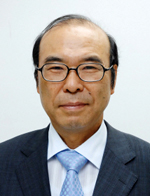 Professor Dong-Yol Yang received an award for scholar of the year 2013 from the Korean mechanical engineering community
Professor Dong-Yol Yang from the Department of Mechanical Engineering at KAIST was selected as “the scholar of the year 2013” at an annual event held by the Korean Federation of Mechanical Engineering Societies, the Korea Association of Machinery Industry, and other mechanical engineering research institutes in Korea. The event, the Day of the Machines, is the nation’s biggest gathering for engineers, scholars, and researchers in mechanical engineering, at which winners of the awards for the person of the year in academia, business, and engineering are announced.
Professor Yang was chosen for his lifetime achievement as a scholar in the field of three-dimensional shape precision processing by developing an innovative processing technology that contributes to the advancement of mechanical engineering and industry. He also introduced the three-dimensional fast processing to Korea from 1990 and developed world-class subminiature fast processing, the first of its kind in Korea.In 2013, Professor Yang identified geometric deformation elements in mechanical engineering for the first time in the world, an essential component for nano mobile system and received the best conference paper award at the 3M-Nano International Conference.
2014.01.05 View 10016
Professor Dong-Yol Yang received an award for scholar of the year 2013 from the Korean mechanical engineering community
Professor Dong-Yol Yang from the Department of Mechanical Engineering at KAIST was selected as “the scholar of the year 2013” at an annual event held by the Korean Federation of Mechanical Engineering Societies, the Korea Association of Machinery Industry, and other mechanical engineering research institutes in Korea. The event, the Day of the Machines, is the nation’s biggest gathering for engineers, scholars, and researchers in mechanical engineering, at which winners of the awards for the person of the year in academia, business, and engineering are announced.
Professor Yang was chosen for his lifetime achievement as a scholar in the field of three-dimensional shape precision processing by developing an innovative processing technology that contributes to the advancement of mechanical engineering and industry. He also introduced the three-dimensional fast processing to Korea from 1990 and developed world-class subminiature fast processing, the first of its kind in Korea.In 2013, Professor Yang identified geometric deformation elements in mechanical engineering for the first time in the world, an essential component for nano mobile system and received the best conference paper award at the 3M-Nano International Conference.
2014.01.05 View 10016 -
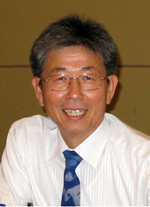 Professor Suk-Joo Na Invited to Finland as Distinguished Professor
Professor Suk-Joo Na, from the Department of Mechanical Engineering at KAIST, has been invited as a distinguished professor for an international research project in Finland.
As a leading scientist in the field of arc welding and numerical analysis of the laser welding process, Na will assemble a research group for the interpretation of the welding processes for three years at the VVT Technical Research Centre of Finland beginning in January of 2014.
The project was established to improve the research level and national competitiveness of Finland by inviting leading international scientists to the National Technology Agency of Finland and Academy of Finland since 2006 and over one hundred projects have been carried out thus far. A total of 17 billion won will be invested for the eleven new projects selected this year. Professor Na said, “The fusion welding field contains important technology for improving the competitiveness of mechanical products of Finland. Improvements in productivity, the life cycles of products, and energy saving through interpretation technology for the numerical analysis of the welding process will make a huge impact on the national economy of Finland.”
2013.12.24 View 10206
Professor Suk-Joo Na Invited to Finland as Distinguished Professor
Professor Suk-Joo Na, from the Department of Mechanical Engineering at KAIST, has been invited as a distinguished professor for an international research project in Finland.
As a leading scientist in the field of arc welding and numerical analysis of the laser welding process, Na will assemble a research group for the interpretation of the welding processes for three years at the VVT Technical Research Centre of Finland beginning in January of 2014.
The project was established to improve the research level and national competitiveness of Finland by inviting leading international scientists to the National Technology Agency of Finland and Academy of Finland since 2006 and over one hundred projects have been carried out thus far. A total of 17 billion won will be invested for the eleven new projects selected this year. Professor Na said, “The fusion welding field contains important technology for improving the competitiveness of mechanical products of Finland. Improvements in productivity, the life cycles of products, and energy saving through interpretation technology for the numerical analysis of the welding process will make a huge impact on the national economy of Finland.”
2013.12.24 View 10206 -
 KAIST Successfully Demonstrates Mobile Harbor in the Open Sea
Busan, South Korea—Large container ships are no longer required to come into ports to transport cargo, as KAIST has developed an innovative technology that will transform the paradigm of today’s cargo handling operations. A Mobile Harbor is a vessel that carries a large stabilized crane with a smart spreader and multistage trolley system, enabling the loading and unloading of ship cargo on the wavy open sea. Following a successful docking of two vessels at sea in April of this year, KAIST conducted a full scope of Mobile Harbor operations in the inner sea of Busan, South Korea, on June 29, 2011.
Initiated in 2009, the Mobile Harbor (MH) is one of the university’s flagship research projects, which aims to provide a new growth engine that will lead the Korean economy to the next level of advancement, and to develop green technology through multidisciplinary and convergence research. The idea of MH came to light when thinking outside the box (why can’t a harbor go out to meet a ship on voyage and retrieve goods instead of ships coming into the harbor?) to improve problems relating to the current maritime transport system, such as port congestion, environmental issues caused by heavy sea transport, increased demand for supersized container ships, and the need for port construction and expansion.
The essential technology to establish a Mobile Harbor is a docking system and crane system that can overcome the obstacles imposed by the sea, i.e., waves and wind. Connecting two operating vessels of different sizes in the unpredictable and ever-changing environment of the sea was regarded as “impossible” and had never been tried before, but, on April 26, 2011, KAIST successfully demonstrated the technology to moor vessels safely and securely.
The Mobile Harbor has a unique way of mooring vessels that are anchored at sea: its flexibly designed robot arms with a square-shape vacuum suction pad at the tip reach out and attach to the hull of a container ship for docking. Each robot arm is connected to a cable and winch that further add stability to the Mobile Harbor. Foam-filled fenders are placed between the Mobile Harbor and the container ship, thereby maintaining a safe distance to prevent collisions.
The crane system consists of a multistage trolley, smart spreader, and tension controller, all of which provide the crane with functionality and stability to move around cargo containers in the sea. The crane system also has various sensors like cameras and laser scanners, and therefore, it can gauge the movement of the spreader and ships as well as trace a target container in real time. As a result, the spreader, a container grabbing device, is free from the swing motions when lifting and putting down cargo and grabs a target container safely in the wavy open sea.
During today’s at-sea demonstration in Busan, a research team from the KAIST Mobile Harbor Center docked a Mobile Harbor (a barge ship) right next to a container vessel (the other barge ship) and repeated freight transport operations between the two ships, presenting the great potential to commercialize the Mobile Harbor technology.
The project has been implemented in collaboration with industries, research institutes, and universities in such fields as mechanical engineering, robotics, automation engineering, and ocean systems engineering. The demonstration proceeded with a wide range of participants including researchers, engineers, government officials, and entrepreneurs from Korea and around the world.
Byung-Man Kwak, Director of the KAIST Mobile Harbor Center, explained his feelings on the successful demonstration:
“It’s been a remarkable journey to develop a Mobile Harbor from scratch, and I’m genuinely thrilled to showcase what we have accomplished so far. Today’s demonstration of Mobile Harbor’s core technologies will really change the face of our maritime transportation system. We will be able to deliver more goods to global markets and consumers via sea route, not necessarily building more ports or expanding the existing harbors. KAIST’s Mobile Harbor will also significantly cut down the high cost related to overland transportation of cargo and in return, contribute to the reduction of carbon emission.”
The Center has received much interest in possible market migration and broader application of the Mobile Harbor from businesses and organizations, e.g., US Office of Naval Research, King Fahd University of Petroleum and Minerals, Saudi Aramco, POSCO, and the Korean Navy.
2011.07.06 View 17558
KAIST Successfully Demonstrates Mobile Harbor in the Open Sea
Busan, South Korea—Large container ships are no longer required to come into ports to transport cargo, as KAIST has developed an innovative technology that will transform the paradigm of today’s cargo handling operations. A Mobile Harbor is a vessel that carries a large stabilized crane with a smart spreader and multistage trolley system, enabling the loading and unloading of ship cargo on the wavy open sea. Following a successful docking of two vessels at sea in April of this year, KAIST conducted a full scope of Mobile Harbor operations in the inner sea of Busan, South Korea, on June 29, 2011.
Initiated in 2009, the Mobile Harbor (MH) is one of the university’s flagship research projects, which aims to provide a new growth engine that will lead the Korean economy to the next level of advancement, and to develop green technology through multidisciplinary and convergence research. The idea of MH came to light when thinking outside the box (why can’t a harbor go out to meet a ship on voyage and retrieve goods instead of ships coming into the harbor?) to improve problems relating to the current maritime transport system, such as port congestion, environmental issues caused by heavy sea transport, increased demand for supersized container ships, and the need for port construction and expansion.
The essential technology to establish a Mobile Harbor is a docking system and crane system that can overcome the obstacles imposed by the sea, i.e., waves and wind. Connecting two operating vessels of different sizes in the unpredictable and ever-changing environment of the sea was regarded as “impossible” and had never been tried before, but, on April 26, 2011, KAIST successfully demonstrated the technology to moor vessels safely and securely.
The Mobile Harbor has a unique way of mooring vessels that are anchored at sea: its flexibly designed robot arms with a square-shape vacuum suction pad at the tip reach out and attach to the hull of a container ship for docking. Each robot arm is connected to a cable and winch that further add stability to the Mobile Harbor. Foam-filled fenders are placed between the Mobile Harbor and the container ship, thereby maintaining a safe distance to prevent collisions.
The crane system consists of a multistage trolley, smart spreader, and tension controller, all of which provide the crane with functionality and stability to move around cargo containers in the sea. The crane system also has various sensors like cameras and laser scanners, and therefore, it can gauge the movement of the spreader and ships as well as trace a target container in real time. As a result, the spreader, a container grabbing device, is free from the swing motions when lifting and putting down cargo and grabs a target container safely in the wavy open sea.
During today’s at-sea demonstration in Busan, a research team from the KAIST Mobile Harbor Center docked a Mobile Harbor (a barge ship) right next to a container vessel (the other barge ship) and repeated freight transport operations between the two ships, presenting the great potential to commercialize the Mobile Harbor technology.
The project has been implemented in collaboration with industries, research institutes, and universities in such fields as mechanical engineering, robotics, automation engineering, and ocean systems engineering. The demonstration proceeded with a wide range of participants including researchers, engineers, government officials, and entrepreneurs from Korea and around the world.
Byung-Man Kwak, Director of the KAIST Mobile Harbor Center, explained his feelings on the successful demonstration:
“It’s been a remarkable journey to develop a Mobile Harbor from scratch, and I’m genuinely thrilled to showcase what we have accomplished so far. Today’s demonstration of Mobile Harbor’s core technologies will really change the face of our maritime transportation system. We will be able to deliver more goods to global markets and consumers via sea route, not necessarily building more ports or expanding the existing harbors. KAIST’s Mobile Harbor will also significantly cut down the high cost related to overland transportation of cargo and in return, contribute to the reduction of carbon emission.”
The Center has received much interest in possible market migration and broader application of the Mobile Harbor from businesses and organizations, e.g., US Office of Naval Research, King Fahd University of Petroleum and Minerals, Saudi Aramco, POSCO, and the Korean Navy.
2011.07.06 View 17558 -
 Displaybank, KAIST Develops Flexible Display Metal Wiring Technology, May 27, 2011
On May 26, Korea Advanced Institute of Science (KAIST) announced that team of Prof. Yang from the Department of Mechanical Engineering developed flexible display metal wiring manufacturing-technology. For the article, please follow the link,
http://www.displaybank.com/eng/info/sread.php?id=5877
2011.05.31 View 9485
Displaybank, KAIST Develops Flexible Display Metal Wiring Technology, May 27, 2011
On May 26, Korea Advanced Institute of Science (KAIST) announced that team of Prof. Yang from the Department of Mechanical Engineering developed flexible display metal wiring manufacturing-technology. For the article, please follow the link,
http://www.displaybank.com/eng/info/sread.php?id=5877
2011.05.31 View 9485 -
 Professor Min Beom Ki develops metamaterial with high index of refraction
Korean research team was able to theoretically prove that a metamaterial with high index of refraction does exist and produced it experimentally.
Professor Min Beom Ki, Dr. Choi Moo Han, and Doctorate candidate Lee Seung Hoon was joined by Dr. Kang Kwang Yong’s team from ETRI, KAIST’s Professor Less Yong Hee’s team, and Seoul National University’s Professor Park Nam Kyu’s team. The research was funded by the Basic Research Support Program initiated by the Ministry of Education, Science, and Technology and Korea Research Federation.
The result of the research was published in ‘Nature’ magazine and is one of the few researches carried out by teams composed entirely of Koreans.
Metamaterials are materials that have physical properties beyond those materials’ properties that are found in nature. It is formed not with atoms, but with synthetic atoms which have smaller structures than wavelengths.
The optical and electromagnetic waves’ properties of metamaterials can be altered significantly which has caught the attention of scientists worldwide.
Professor Min Beom Ki’s team independently designed and created a dielectric metamaterial with high polarization and low diamagnetism with an index of refraction of 38.6, highest synthesized index value.
It is expected that the result of the experiment will help develop high resolution imaging system and ultra small, hyper sensitive optical devices.
2011.02.23 View 18468
Professor Min Beom Ki develops metamaterial with high index of refraction
Korean research team was able to theoretically prove that a metamaterial with high index of refraction does exist and produced it experimentally.
Professor Min Beom Ki, Dr. Choi Moo Han, and Doctorate candidate Lee Seung Hoon was joined by Dr. Kang Kwang Yong’s team from ETRI, KAIST’s Professor Less Yong Hee’s team, and Seoul National University’s Professor Park Nam Kyu’s team. The research was funded by the Basic Research Support Program initiated by the Ministry of Education, Science, and Technology and Korea Research Federation.
The result of the research was published in ‘Nature’ magazine and is one of the few researches carried out by teams composed entirely of Koreans.
Metamaterials are materials that have physical properties beyond those materials’ properties that are found in nature. It is formed not with atoms, but with synthetic atoms which have smaller structures than wavelengths.
The optical and electromagnetic waves’ properties of metamaterials can be altered significantly which has caught the attention of scientists worldwide.
Professor Min Beom Ki’s team independently designed and created a dielectric metamaterial with high polarization and low diamagnetism with an index of refraction of 38.6, highest synthesized index value.
It is expected that the result of the experiment will help develop high resolution imaging system and ultra small, hyper sensitive optical devices.
2011.02.23 View 18468 -
 Soyeon's Odyssey by Space Travel, Feb. 1, 2011
Soyeon Yi, an alumna of KAIST who joined the Soyuz TMA-12 mission to the International Space Station in 2008 and successfully returned to the Earth after completion of her mission. She is often cited as the first Korean astronaut who had spaceflight. She recently had an interview with an Australian based online newspaper that publishes space related news stories. For the interview, please go to the link.
http://www.space-travel.com/reports/Soyeon_Odyssey_999.html
2011.02.02 View 10641
Soyeon's Odyssey by Space Travel, Feb. 1, 2011
Soyeon Yi, an alumna of KAIST who joined the Soyuz TMA-12 mission to the International Space Station in 2008 and successfully returned to the Earth after completion of her mission. She is often cited as the first Korean astronaut who had spaceflight. She recently had an interview with an Australian based online newspaper that publishes space related news stories. For the interview, please go to the link.
http://www.space-travel.com/reports/Soyeon_Odyssey_999.html
2011.02.02 View 10641 -
 Korea should find niche in space race, Korea Herald, December 20, 2010
A proud alumna of KAIST, Dr. Yi So-Yeon, who went to the International Space Station in the outer space for the first time as a Korean in 2009, had an interview with the Korea Herald. In the interview, she talks about her experience in working at the space station and her personal plans for the future as a researcher and astronaut. For the article, please click the link:
http://www.koreaherald.com/lifestyle/Detail.jsp?newsMLId=20101220000999
2010.12.21 View 11292
Korea should find niche in space race, Korea Herald, December 20, 2010
A proud alumna of KAIST, Dr. Yi So-Yeon, who went to the International Space Station in the outer space for the first time as a Korean in 2009, had an interview with the Korea Herald. In the interview, she talks about her experience in working at the space station and her personal plans for the future as a researcher and astronaut. For the article, please click the link:
http://www.koreaherald.com/lifestyle/Detail.jsp?newsMLId=20101220000999
2010.12.21 View 11292